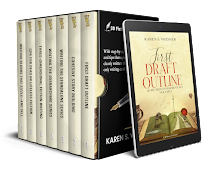Oldies But Goodies
{Put This One on Your TBR List} Book Review
Subseries 3: The Tawny Man Trilogy (The Realm of the
Elderlings)
by Robin Hobb
by Karen S. Wiesner
Be aware
that there may be spoilers in this review. Also, reading my previous appraisals
will foster understanding about certain facts about this umbrella series that
are required to make sense of things included in this particular review.
In an attempt to spend less money on books that half the time I don't
even enjoy, early in 2025, I figured out how to check out ebooks from the app
my local library uses for this purpose. Utilizing Libby, I can check out ebooks
and audiobooks. Unfortunately, the selection of material is limited. A lot of
the books I like to read aren't available on it, but I was glad to see that
most of Robin Hobb's titles are available. It's just a lot of waiting when I
"place a hold" and patiently endure the, at times lengthy, delay in it
becoming available for me to read.
Robin Hobb is the author of The Realm
of the Elderlings. Within this umbrella series, she's written five
"miniseries" and numerous short stories. In previous Alien Romances
Blog reviews, I covered The Inheritance
& Other Stories, which contains a couple Realm of the Elderlings
offerings. I also reviewed the first two trilogies within this series, The
Farseer and The LiveShip Traders trilogies, along with two miscellaneous
novellas in the series, "The Willful Princess and the Piebald Prince"
and "Words Like Coins".
The Farseer Trilogy was focused
on Fitz, the illegitimate son of Prince Chivalry of the royal line presiding
over the Six Duchies. In that first subset, we learned something of the Elderlings
(including dragons) and their ancient cities and settlements around the world,
especially in the Rain Wilds. In the second subseries, The Liveship Traders
Trilogy, we moved away from the royal Farseer lineage and problems within the nobility
to focus on "liveships", which are the outer cocoons of sea
serpents that were in the process of transforming into a dragon.
These logs were buried in the destroyed city of the Elderlings in the Rain
Wilds and found by traders who excavated the ruins for valuable, magical
artifacts.
The Tawny Man Trilogy includes the following novels:
Fool's Errand, Book 1 (2001)
The Golden Fool, Book 2 (2002)
Fool's Fate, Book 3 (2003)
Once again, we return to Fitz from the first Elderlings subseries, The
Farseer Trilogy. He's now in his mid-thirties. It's been fifteen years since
the events of Farseer. The events of all previous stories that I mentioned
above reviewing before play into each of these stories in a wonderfully
cohesive and illuminating way that I really enjoyed. I felt like I was pulling
threads from different tapestries until they began to fit into one. The author is
to be lauded in how she meshed her subseries seamlessly, at least for the most
part.
As a preface to this review, in this series there are two
"magical" talents: With the Skill, a person can reach out to
another's mind, no matter how far away, and read thoughts and influence
thinking and behavior. An even older magic is the Wit, in which humans feel
such a kinship with animals, they share thoughts and behaviors, sometimes
becoming so bonded that they themselves become little more than beasts. The
strength of the bond can also lead to performing powerful attacks. The Wit is
looked upon with scorn and fear by most humans.
In the first book of the trilogy, Fool's
Errand, Fitz is living a quiet life in the middle of nowhere with his wolf
Nighteyes, to whom he's Wit-bonded, and a foundling son he's adopted as his own
named Hap.
In The Tawny Man, few know Fitz as anyone but Tom Badgerlock. Most
believe FitzChivalry of the royal line to be dead. The man who taught Fitz as
an assassin, Chade, visits Tom. In previous stories, Fitz conceived with the
queen as King Verity used his body for the purpose of providing an heir to the
throne. Their son has shown signs of being both Witted and possessing the
Skill. Prince Dutiful is untutored and there are few if any teachers of both
abilities in the current climate. At Chade's request that Tom teach Dutiful,
Tom protests that his knowledge of both of these powers is incomplete and
erratic. Chade also tells Tom of the unrest among the Witted in the land. The
rebels call themselves the Piebalds. (The story of Piebald origins is told in "The Willful Princess and the Piebald
Prince", a favorite of mine in this series.)
Chade leaves after Tom refuses to train the prince, and later the Fool (who
has remade himself in many ways, shapes and forms in his appearances in the
series, becoming known in this trilogy as The Tawny Man, Lord Golden) visits
him. In previous trilogies within the series, the question of the Fool's
identity was revealed to be ever-changing. The Fool worked as an actual
"fool" at court in Buckkeep for the king in the first subseries. In
the second, he was a she, the carver Amber in Bingtown. I'd wondered in my
review of the previous subseries The Liveship Traders Trilogy how/when this anomaly
was revealed. Now I know it's in The Tawny Man Trilogy that the facts behind
this situation come to life. The Fool is much more than any have previously
suspected--a being called a White Prophet whose purpose is to set the world on
a better path. As such, this creature invents and reinvents itself in order to
serve its impetus. The Catalyst is the one who makes the changes, and that one
is Fitz. The Fool reveals in this book that he doesn't believe he's fulfilled
his destiny correctly--during the time he was Amber, he went awry and therefore
warped all that came afterward.
In Fool's Errand, Prince Dutiful
is believed to have been kidnapped by Piebalds. In truth, Dutiful has been
enslaved by a Witted Woman who died and forced her essence into an unwilling
cat. Lord Golden and Tom, appearing as his servant, must rescue Prince
Dutiful--possibly from himself.
In The Golden Fool, Book 2,
Tom intends to return to court and train Prince Dutiful with the intention of
forming a coterie of Skill users. The group will include Dutiful, Lord Golden and
Chade, along with the disabled servant of Chade's named Thick. Fitz's daughter
with Molly, Nettle, also possesses the Skill, and she reaches out to Tom
against the will of the person she believes to be her father--Burrich (from the
first trilogy), who's now married to Fitz's love Molly and they have a Skilled
son together named Swift. Additionally, a Witted coterie is in the works as the
scourge against this magic is being actively turned over. The kingdom wants to
show that Wit is a talent instead of a distrusted curse to fear.
In this story, the Fool reveals his deepest feelings to Tom, believing
him to be his beloved. But Tom can't accept this, and a schism forms between
them. There's also a thread about the princess of the Out Islands potentially
marrying Prince Dutiful to establish an alliance between their people, thus
reunited the Six Duchies. However, she requires that, to win her hand, he must
bring her the head of the dragon IceFyre, who's trapped beneath the ice on the
isle of Aslevjal. The Golden Fool has foretold that he'll die there trying to
stop this fate from happening.
The trilogy concludes with Fool's
Fate. Tom makes an effort to steal away by ship with the coteries to go to
the Out Islands and give the princess what she needs to accept Dutiful's troth.
Tom wants to prevent the Fool's death at all cost, but fate isn't so easily thwarted.
The Fool joins them despite their scheming, and together the Witted and Skilled
coteries attempt to free IceFyre from its prison. However, another White
Prophet would see the dragon killed in order to prevent the Fool's prophecy
that dragons would return to the world from being fulfilled. Though the Fool is
destined to die during all these events, Tom refuses to allow it and intends to
do everything in his power to save them both.
While I enjoyed it, I concluded this subseries feeling a bit unsure what
the purpose of it was. More than anything else, The Tawny Man Trilogy seems to
be little more than an extremely long bridge (very close to 5000 pages!)--from
the previous subseries to the next. You get to see events that happened before
play out in the present here and, yes, familiar characters move along toward future
events. Mind you, this isn't so much as a complaint as a comment that left me a
bit baffled. Tom is a complex character, and I didn't always understand him.
Also, in a tiny way, the whole plotline about the Fool's androgynous nature as
a prophet that's reinvented itself over the course of perhaps centuries struck
me as a little far-fetched and convenient to the plot in this subseries.
Finally, apparently unlike, say, the council of wizards in The Lord of the Rings, White Prophets in this series don't work together
and in fact can actively work against each other to see their own ends
fulfilled. Who or what's guiding all that is anybody's guess. I'm not sure how
or even if that'll play out further in the next subseries.
As an aside, the ebook version of Fool's
Errand was over 1,300 pages. It took me 7 hours and 19 minutes to read it.
I was surprised I enjoyed reading an ebook, though it was annoying to drag my
iPad around everywhere so I could snatch a few minutes here and there to read.
It's also frustrating because I have crappy internet and sometimes I couldn't
get the app to load the book so I could read when I wanted to. You never have
that problem with a paperback. But I also didn't spend $30-$75 on purchasing
the three books either used or new. There are trade-offs when reading
traditionally or electronically, I'm learning.
In any case, I enjoyed this trilogy, though it was a good 3000 pages too
long for me. I was eager to see the evolution of the characters as well as the
world The Realm of the Elderlings is set expanded. For whatever reason, I
didn't feel quite as exhausted reading this third subseries as I did those that
came before. I believe the ebook medium had a lot to do with that. But I also
didn't enjoy this subseries in the Realm of the Elderlings as much as the last
one I read. While I do want to get started on the fourth subseries, The Rain
Wilds Chronicles, which has four books instead of just three, and is set in the
city of the ancient Elderlings, I do need another break before I turn to those
paperbacks I own. I suspect that final subseries will at last include
everything I've been looking forward to so eagerly since I found this amazing
series.
Karen Wiesner is an award-winning,
multi-genre author of over 150 titles and 16 series.
Visit her website here: https://karenwiesner.weebly.com/
and https://karenwiesner.weebly.com/karens-quill-blog
Visit her publisher here: https://www.writers-exchange.com/Karen-Wiesner/
 Beware spoilers!
Beware spoilers!
 Beware
spoilers!
Beware
spoilers!






































